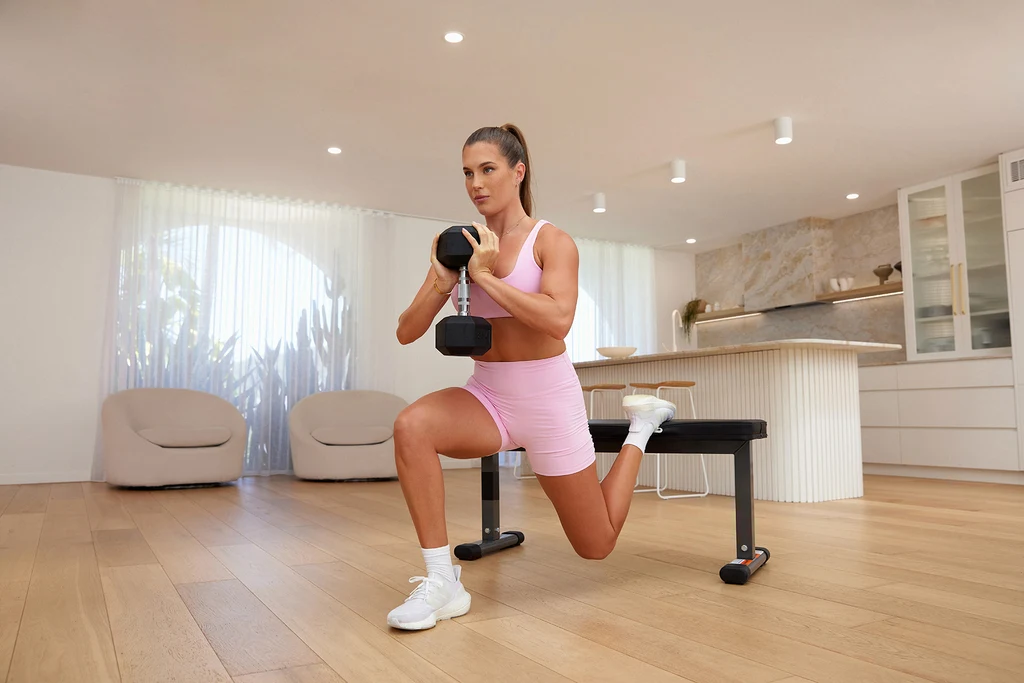8 Of The Best Glute Exercises To Grow Your Glutes
It’s time to level up your lower-body workouts.

October 18, 2019 - Updated February 18, 2025

Regardless of whether you love Pilates, HIIT, bodyweight strength training or heavy lifting, glute exercises are probably on your radar - after all, your glutes are the largest muscle group in your body.
Throughout your daily life and in your workouts, your glutes play an important role in moving and stabilising your body.
As the largest muscle group in your body, glute exercises should be part of any strength training program, as strong glutes can provide serious power to other movements while helping to reduce your risk of muscle imbalances, tightness, pain or injury.
If strengthening or growing your glutes is one of your fitness goals, here are eight of our favourite exercises to include in your routine. Many of these movements feature in Sweat programs such as PWR, PWR Strength, Strength & Sculpt and the Strong Glutes Challenge, and you can also find plenty of individual glute-focused workouts in the On Demand section of the Sweat app.
What are the different glute muscles?
Before we dive into some of the best glute exercises, it pays to have a quick run-through of the three primary muscles that make up your glutes - your gluteus maximus, gluteus medius and gluteus minimus. Underneath these are six supporting muscles (known as the “deep six” or “lateral rotator group”) that help to rotate your femur in your hip joint.
Your gluteus maximus is the largest muscle in your body and plays an important role in stabilising your pelvis, rotating your hips, and hip extension - pulling your leg backwards.
Your gluteus medius is the medium-sized muscle that helps with side-stepping and hip abduction (moving your leg away from the midline of your body), externally rotating the leg when it’s extended behind you, or internally rotating the leg when it is flexed in front of you.
Your gluteus minimus is the smallest of the three and assists with abducting the hip for side-stepping or any outwards movement of the hip. This muscle is also engaged when you make circular movements with your thigh.
The six supporting muscles are the obturator internus, quadratus femoris, obturator externus, gemellus superior, gemellus inferior and the piriformis.
The glute muscles located underneath the gluteus maximus connect the hip bone to the femur (thigh bone) and to the base of the spine at the coccyx and sacrum, which is why tight or weak glutes can be the cause of lower back pain.

8 of the best glute exercises
Warmed up with some light cardio? Check. Primed your body and mind with a few glute activation exercises? Check. Okay, it’s time to get into some work.
These are some of our go-to glute exercises, many of which are compound exercises - meaning they engage multiple major muscle groups at once. Yes, your glutes will be the focus, but you’ll also be strengthening muscles such as your hamstrings, quads, core and hip flexors.
Most of these exercises can be performed with just your bodyweight or using free weights like dumbbells, kettlebells or a barbell.
If you’re a beginner to strength training or any of these exercises, start by focusing on your form and mastering the movement with a light to moderate weight. For more advanced fitness levels and heavy lifters, choose a weight that feels challenging but still allows you to complete all your reps with great form. With a moderate weight, 12-15 reps per set is a good range to aim for. With a heavy weight, 6-12 reps is more realistic.
And when what was once hard starts to feel easy, you know you’re ready to go heavier!
Squats
No surprises here! Squats are one of the best exercises for working your glutes and building lower-body strength as they work all of your glute muscles in one hit, and you can start with your bodyweight, dumbbells or adding a resistance band around your thighs, then challenge yourself with heavier weights using a barbell or a Smith machine.
Sumo squats
While we’re on the topic of squats, we couldn’t go past one of the most powerful squat variations - the sumo squat. Simply position your feet a bit further than hip-width apart, turn your toes slightly outwards, and then squat nice and low with your knees tracking outwards over your toes.
Because of the change in positioning, sumo squats can work your glute muscles in a slightly different way while also targeting your inner thighs more than a regular squat. Feel free to hold a dumbbell or kettlebell, letting it hang with your arms fully extended, or perform sumo squats with a barbell.
Hip thrusts
Glute bridges or hip thrusts are a very effective way to engage and strengthen your glutes, with plenty of potential to see yourself progress and lift heavy. If you don’t have access to a barbell, holding a dumbbell on your hips will do the trick. You can also perform glute bridges lying on your back if you don't have a bench.
To keep the tension in your glutes rather than your lower back, make sure your body forms one nice straight line from knee to neck at the top of the movement - you don’t want your hips arching up towards the ceiling.
Deadlifts
Deadlifts are a key lift in Kelsey Wells’ popular PWR Strength program and an incredible exercise for working your glutes and your entire posterior chain - that’s all the muscles down the back of your body. Similar to squats and hip thrusts, you can see your strength gains in action every time you feel comfortable enough to add more weight!
To change up your deadlifts you can also really isolate your glutes and hamstrings with RDLs or Romanian deadlifts. In comparison to conventional deadlifts where the barbell starts on the floor and requires more of a knee-bend to lift it, RDLs involve lowering the weight just below your knees, keeping your legs straighter throughout the movement.
Lunges
Although lunges can feel like a quad-focused exercise, your glutes should be getting a great workout, too. If you’re not feeling it in your glutes, we suggest slowing your reps down to fully engage the muscles and increase your time under tension. You can also try changing between forward and reverse lunges for slightly different muscle focus.
Glute kickbacks
Glute kickbacks and donkey kicks really isolate your glutes and can be performed with a resistance band, ankle weights or standing using a cable machine for more of a challenge. Similar to lunges, speed isn’t impressive here. Move with steady control to keep those muscles engaged.
Whether you’re on all fours or standing, the difference between a glute kickback and a donkey kick is the position of your knee. Your knee is bent at a 90-degree angle in a donkey kick, and extended in a glute kickback.
Bulgarian split squats
A lot of people love to hate Bulgarian split squats and for good reason - they burn. This unilateral exercise can help to build stability in your glutes, target one side at a time, improve your balance and even out any strength imbalances. In terms of weights, you can either hold a dumbbell or kettlebell at your chest, hold two dumbbells down by your sides, or position a barbell on your back.
If you’re feeling these more in your quads than your glutes, lean your torso slightly forward, make sure your foot is flat the whole time, go even lower towards the floor, and focus on pushing through your heel to stand up.
Step ups
This unilateral exercise can help to build stability in your glutes, target one side at a time and even out any strength imbalances. With step ups it can be easy to propel yourself off your bottom foot, but this takes some of the work out of your glute. To give your glutes the best workout, move slower and focus on driving into your foot that’s on the box rather than pushing off the foot on the floor.
Find strength through balance
Even if stronger glutes are your goal, following a workout program designed to strengthen your entire body is a good idea to avoid muscle imbalances and keep your upper body strong as you progress in your training.
Following any tough lower body workout, remember to rest those glutes for at least a day - muscle recovery is crucial. With consistent training, plenty of rest and good nutrition, you’ll be well on the way to achieving your fitness goals.

A more empowered you starts with Sweat, and our editorial team is here to bring you the latest fitness tips, trainer recommendations, wellbeing news, nutritional advice, nourishing recipes and free workouts.
* Disclaimer: This blog post is not intended to replace the advice of a medical professional. The above information should not be used to diagnose, treat, or prevent any disease or medical condition. Please consult your doctor before making any changes to your diet, sleep methods, daily activity, or fitness routine. Sweat assumes no responsibility for any personal injury or damage sustained by any recommendations, opinions, or advice given in this article.
Fitness